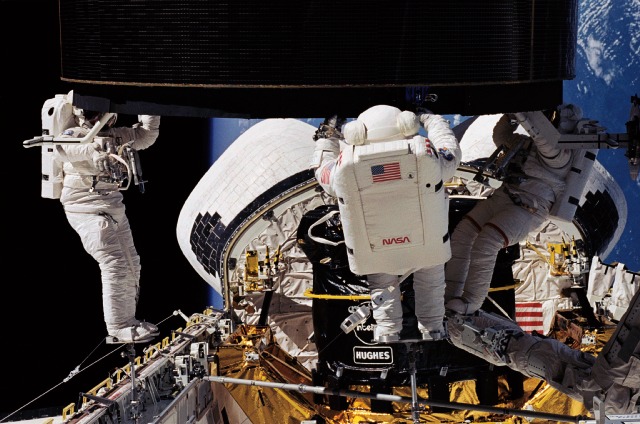
More than two decades ago, on 7 May 1992, the last virgin space shuttle speared for the heavens. Orbiter Vehicle (OV)-105, better known as “Endeavour,” had arisen from a set of structural spares and had been assembled to replace her late sister, Challenger. With the possible exception of Columbia—which flew the very first shuttle mission in April 1981—there is perhaps no other orbiter than Endeavour which made her entrance on-stage in such a dramatic manner. Her first flight would rendezvous, retrieve, and deploy the stranded Intelsat 603 communications satellite and, for the first time, would involve as many as three EVAs, featuring no fewer than four astronauts. As circumstances would transpire, Endeavour would break even that record on STS-49 … and would continue to break records for the rest of her 25-flight career.
Originally scheduled for the evening of 4 May 1992, the launch of STS-49 was postponed until the 7th in order to permit greater conditions of daylight for photographic coverage of the ascent. After a 34-minute delay, caused by marginal weather conditions at one of the Transoceanic Abort Landing (TAL) sites, STS-49 duly thundered into space at 7:40 p.m. EDT on 7 May, and during the next couple of days Intelsat controllers maneuvered their satellite into a “control box,” some six degrees of arc of the shuttle’s orbit. These maneuvers also served to reduce Intelsat’s rotation from 10.5 to around 0.65 rpm. By the 10th, as they approached to within 8 miles (13 km) of the satellite, Thuot and Hieb completed their procedures of suiting-up and were assisted into the airlock by crewmate Akers. Shortly thereafter, at 4:25 p.m. EDT, they opened Endeavour’s outer hatch into the payload bay—then in the pitch black of orbital darkness—and Thuot fastened himself into a foot restraint on the end of the Remote Manipulator System (RMS) mechanical arm, deftly operated by veteran astronaut Bruce Melnick. Drawing closer toward the satellite, Thuot extended the capture bar into position, but the latches failed to latch.
He tried again, without success.
A third attempt was similarly fruitless.
From his station on Endeavour’s aft flight deck, Brandenstein noticed that Intelsat 603 was beginning to oscillate and drift somewhat, “so I got in my chase-it mode, because I had to keep him aligned.” When Thuot’s third attempt failed, Brandenstein had used a “tremendous” amount of propellant and instinctively knew that the chances of success were slim at best. The RMS exacerbated the difficulty, because its joints were being driven into positions which they could not support. “We decided, though consultations with the ground, to get out of there and try another day,” Brandenstein recollected. “That was a pretty low point, because when we left, it had a pretty good rate. We thought we’d lost this $150 million satellite … and Pierre was particularly depressed because, obviously, he thought it was his fault.”
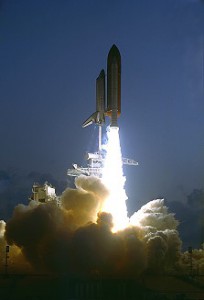
Thuot and Hieb returned inside Endeavour after three hours and 43 minutes, and later that evening Hughes engineers confirmed that they had managed to stabilize Intelsat. Next day, at 4:30 p.m. EDT on 11 May, the spacewalkers were back outside for a second attempt. “Instead of doing it at night, we were going to wait and do it in daylight,” Brandenstein said. “We decided we weren’t going to even make an attempt until everything was just perfect. Pierre went in and the rotation slowed down.” From Hieb’s position, it looked as if Thuot had completed the capture, but, alas, the satellite again began to oscillate. The astronaut’s alignment was unquestionably correct, but the capture bar—described in yesterday’s AmericaSpace history article—refused to seat itself properly and Intelsat wobbled. A few weeks after the mission, Thuot explained to this author that the satellite “was much more dynamic than our training had led us to believe.”
As the disappointed spacewalkers returned inside the cabin for the second time—this time after 5.5 hours—they at least knew that the Hughes engineers could regain control of Intelsat 603 for another attempt. However, although propellant reserves allowed for it, three separate rendezvous on a single shuttle mission had never been attempted, and Brandenstein recommended a day off to plan for the third attempt. In an interview for the Smithsonian, Rick Hieb remembered that the evening of the 11th was a sombre time. At one point, Kevin Chilton, the STS-49 pilot and the only “rookie” member of the crew, joined Hieb on the flight deck and the pair entered an impromptu brainstorming session. It was a session that would mark a significant turnaround in the fortunes of a mission which seemed snake-bitten.
As Hieb and Chilton talked, other members of the crew floated upstairs to join them. The main concern was where to manually grab Intelsat. The top of the satellite, where the delicate antennas were located, was not ideal, and it was Bruce Melnick who suggested an EVA with not two spacewalkers, but three. No excursion in history had ever involved more than two members, partly due to safety concerns and partly because of the sheer practicality of getting three people into the tiny airlock. On the other hand, Endeavour carried four suits for Thuot, Hieb, Thornton, and Akers, so in theory it was a possibility.
“When Bruce said that,” recalled Hieb, “a big mental switch flipped over, at least for me. In my mind, having a third set of hands out there meant that we would be successful, although we weren’t yet sure how.”
Mission Control knew that the astronauts were still awake, because Endeavour’s monitors had not been turned off. At length, the crew turned them off and continued talking in the dark, but eventually called the ground with Melnick’s idea. Years later, Brandenstein remembered that it was Chilton who sketched out the practicalities of the three-person EVA scenario and held it in front of the television camera to allow mission controllers to see it. “The big choke point,” Brandenstein said, “was can you put three people in the airlock to get them outside?” In the Houston water tank, fellow astronauts Story Musgrave, Jim Voss, and Michael “Rich” Clifford donned suits and demonstrated the techniques and geometries involved in setting themselves up to accomplish the feat.
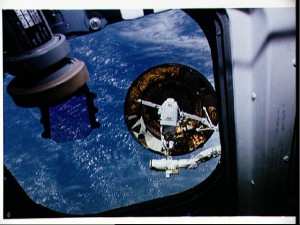
Their consensus: It was doable. On the evening of 12 May, Capcom Charles “Sam” Gemar radioed Mission Control’s approval to the crew.
Late on 13 May, the third attempt got underway. Truss members belonging to the Assembly of Station by EVA Methods (ASEM)—a Space Station Freedom demonstration payload, to be used during EVA tests later in the mission—were removed and arranged into a triangular structure for Thuot, Hieb, and Akers to anchor their feet. Brandenstein positioned the orbiter directly beneath Intelsat 603, and controllers verified that its surface temperatures would not exceed the 160 degrees Celsius (320 degrees Fahrenheit) touch limit of the astronauts’ gloves. With Hieb close to the starboard payload bay wall, Akers in the center, attached to an ASEM strut, and Thuot on the end of the RMS on the port side, the astronauts could do little but watch as Endeavour drew closer. They studied its slow rotation for about 15 minutes, until, on Hieb’s call, they moved in for the capture.
All at once, Thuot spotted a slight wobble. He called the attempt off.
Shortly thereafter, they tried again. This time, at last, the three men grabbed the satellite and held it firmly. The time was 7:55 p.m. EDT. “I actually thought the other two guys had stopped it from rotating,” Thuot said later, “so little force had I applied. Very gently, the thing came to a stop.” From the flight deck, Dan Brandenstein asked them if they had a good grasp. On Thuot’s response in the affirmative, the commander was able to advise ground controllers, with more than a hint of relief: “Houston, I think we’ve got a satellite!”
With Intelsat snared, the astronauts removed the steering wheel and installed an extension to the capture bar, which Melnick grappled using the RMS. The satellite was then positioned above its 23,000-pound (10,430-kg) Orbus-21 solid-fueled perigee kick motor, which sat vertically in its cradle. After closing four docking clamps to secure the pair, and attaching two electrical umbilicals between Intelsat and the motor itself, the spacewalkers set a pair of deployment timers and retreated to Endeavour’s airlock. Meanwhile, Kathy Thornton prepared to activate the springs to deploy the payload. At first, it did not move. “They had made a change in the wiring of the deploy system,” recalled Brandenstein, “and the change never made it through the process [and] never got into the checklist. Fortunately, somebody in Mission Control apparently knew about it. They just quick called up a different switch sequence and she did that sequence and it went.” Deployment occurred at 12:53 a.m. EDT on 14 May, and the satellite vacated the payload bay. Less than an hour later, the three spacewalkers repressurized the airlock and returned inside the cabin.
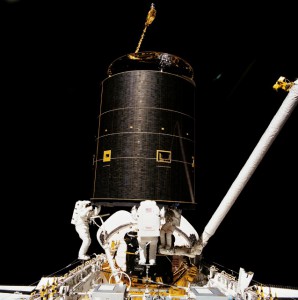
Speaking a decade or more after the flight, Dan Brandenstein regarded those few days of STS-49 as “one of those missions from hell,” and for newly-appointed NASA Administrator Dan Goldin it was truly “a baptism of fire.” Nevertheless, at 1:25 p.m. EDT on the following day, 15 May, Intelsat 603’s new motor ignited perfectly, and it was on-station in geosynchronous orbit by the 21st. As well as becoming the first shuttle crew to accomplish as many as three EVAs in a single mission—a record which they would break with a fourth excursion—the triumphant three-man spacewalk established itself as the longest in history. Their eight hours and 29 minutes outside would remain unbroken until March 2001. By now, the difficulties had prompted the Mission Management Team (MMT) to extend STS-49 by 48 hours from its planned seven-day duration. On 14 May, a record-breaking fourth EVA got underway when Akers and Kathy Thornton ventured outside for the ASEM station tests. Originally scheduled to involve two EVAs—one by Thornton and Akers and the second by Thuot and Hieb—the Intelsat 603 retrieval forced the cancellation of one spacewalk.
Activities included the construction of a pyramid-shaped truss, the unberthing of a Mission-Peculiar Equipment Support Structure (MPESS)—maneuverd by the RMS—and efforts to evaluate the ability of spacewalkers to work at positions “above” and “forward” of the payload bay, including “over the nose” of the shuttle. The MPESS contained two node boxes for the pyramid, a releasable grapple fixture and interface plate, and a truss leg and strut dispenser. Five crew rescue techniques were to be trialed, including a lasso-like “astro-rope,” a seven-section telescoping pole and a hand-held propulsive device. The latter, according to NASA’s STS-49 press kit, was “a redesigned hand-held maneuvering unit from the Skylab program,” in which pressurized nitrogen jets were employed as thrusters.
During their seven hours and 43 minutes in the payload bay, Thornton and Akers completed the construction and disassembly of the ASEM attachment fixture, tested the propulsive device, affixed six of eight legs onto the MPESS, and, unexpectedly, were called upon to manually stow Endeavour’s Ku-band antenna, which had experienced a positioning motor failure. According to NASA’s post-mission report, this EVA was planned to be RMS-intensive, although the mechanical arm was used to accomplish only a single ASEM task and the spacewalkers’ timeline was further impacted by the Ku-band activity.
Returning inside Endeavour’s airlock after the excursion, the astronauts of STS-49 could now boast four EVAs—lasting a cumulative of 25 hours and 27 minutes—which had snatched success from the fangs of defeat. The physical appearance of the four spacewalkers in their snow-white suits was also quite distinct from previous missions, all of which had featured no more than two members. In order to distinguish them, Thuot (designated “EV1”) wore red stripes around his suit legs, whilst Hieb (EV2) wore a pure-white suit, and, for the first time, Thornton (EV3) wore dashed stripes around her suit legs and Akers (EV4) wore red diagonal hatches around his suit legs. In spite of the remarkable achievement of performing four back-to-back EVAs on a single mission, only relatively minor glitches plagued the spacewalkers—a failed joint on one of the portable foot restraints, a loud noise over the headsets when power tools were being used, and a battery problem, among others—and their suits held up exceptionally well.
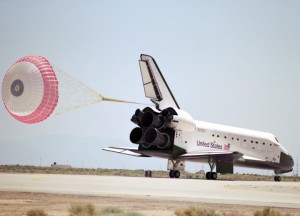
Endeavour’s return to Earth on 16 May 1992, concluding her first flight in a 25-voyage career, brought with it a number of test objectives, the most visible of which was the deployment of the shuttle’s long-awaited drag chute on the runway. Measuring 39 feet (11.8 meters) in diameter when fully unfurled, the chute was designed to reduce steering problems and relieve stress on the shuttle’s brakes and tires, which had suffered particularly significant damage on Mission 51D in April 1985. In the post-Challenger era, options to improve landing safety were extensively evaluated. As well as the drag chute, options included the emplacement of an arresting barrier at the end of the runway or the installation of a special “skid” on the landing gear. In the event of a blown tire, the latter was meant to preclude the chance of a second tyre failing, effectively providing a “roll-on-rim” capability for a predictable rollout pattern.
Design requirements for the drag chute—which was tested extensively at NASA’s Dryden Flight Research Center at Edwards Air Force Base, Calif.—included an ability to bring an orbiter to a halt in less than 8,200 feet (2,500 meters) with an 11-mile (17.7-km) tail wind and maximum braking at a ground speed of 160 mph (257 km/h). Housed in a cylindrical container, just beneath the shuttle’s vertical stabilizer fin, the chute was to be manually deployed by the pilot after main gear touchdown and ahead of nose gear touchdown. It would then be jettisoned when the rollout speed had dropped to around 70 mph (110 km/h). During re-entry, the orbiter’s main engines were repositioned some 10 degrees “lower” than normal, in order to eliminate the chance of damage to the chute.
Air trials at Dryden in the summer of 1990 saw it fitted to a modified NB-52 carrier aircraft—piloted by former astronaut Gordon Fullerton—which tested it at landing speeds of between 160-230 mph (257-370 km/h), with no negative effects. These trials enabled engineers to predict that it would reduce the shuttle’s landing rollout distance by some 1,000-2,000 feet (300-600 meters). Early in January of the following year, NASA modified its production contract for Endeavour with Rockwell International by $33.3 million to include the design, fabrication, and installation of the chute. Since STS-49 was to be its the first space mission, plans called for it to be deployed after all six wheels—main gear and nose—were firmly on the runway. After an uneventful re-entry, Endeavour’s main gear touched concrete Runway 22 at Edwards, at 1:57 p.m. PDT (4:57 p.m. EDT), followed by the nose a few seconds later.
Then came the chute.
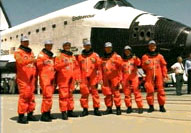
At the pilots’ command, pyrotechnics blew the door away from the chute compartment and a mortar fired, driving out firstly a 10-foot pilot chute, then the main canopy, which “reefed” to 40 percent of its total diameter for a few seconds to lessen the initial structural loads on Endeavour herself. It trailed the orbiter by 89 feet (27 meters) on a 41-foot (12.4-meter) riser. Following the successful operational of the reefing line cutter, the chute blossomed to its fully inflated condition. Photographic analysis of the landing illustrated that the reefed chute rode at a higher angle than anticipated and the door trajectory differed slightly from the NB-52 tests; additionally, its behavior and closeness to the centerline were attributed to the effect of the aerodynamic flow for the fully-open speed brake.
Summing up his fourth and final shuttle mission—for he would retire from NASA in October 1992—Dan Brandenstein was happy with Endeavour’s performance on her maiden voyage. This was particularly important in view of the Intelsat 603 difficulties and the relative paucity of additional time to tend to systems glitches. “They built a beautiful vehicle,” he said, “because it’s based on all the other things that diverted our attention on that flight. It was really nice that Endeavour performed like an old pro.” Indeed, NASA’s official post-mission report highlighted only 36 anomalies, none of which were of sufficient concern to impact the successful conduct of the mission.
In the aftermath of STS-49, the crew themselves would highlight the fact that their mission raised awareness of the need for more EVA experience in the years before the start of construction of Space Station Freedom. At one stage, in the late 1980s, as many as four EVAs per week were envisaged—an astonishing estimate which NASA Administrator Dick Truly deemed totally unacceptable. Yet as the plans for the station matured, it was obvious that the construction process would be EVA-intensive and that required different ways of working and training. “We have to take a good look at the time it takes to do a job,” Brandenstein said. “We need better ways to train so that the learning curve isn’t quite so steep.” Pierre Thuot added that the Intelsat 603 retrieval task was something that the crew “couldn’t train for fully.”
After their return from STS-49, Kathy Thornton and Tom Akers—who would go on to service the Hubble Space Telescope (HST) together in December 1993—took an active role in developing new EVA methods in the Weightless Environment Training Facility (WET-F) in Houston. “Even in the tank, you still have the resistance of water,” Dan Brandenstein recalled, “so you can kick your feet and swim. In zero gravity, we’ve got movies of Tom going to that instinct. You can see him kicking his legs and nothing’s happening. Also, if you move something in the water, as soon as you stop moving it, the reason is the water stops it. But in zero gravity, you start moving something and it just keeps moving until you come back on it. They made some significant chances in the tank training procedures.” The first flight of Endeavour’s career had gone spectacularly well and had played a significant role in shaping the missions—and the assembly of the space station—which would follow.
This is part of a series of history articles which will appear each weekend, barring any major news stories. Next week’s article will remember Faith 7 in May 1963, during which astronaut Gordon Cooper closed out Project Mercury with the United States’ longest and most complex mission to date.
Want to keep up-to-date with all things space? Be sure to “Like” AmericaSpace on Facebook and follow us on Twitter: @AmericaSpace




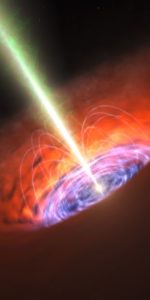
Hi Ben,
Great articles.
If I may make one addition, after the flights completion the ASEM team received a plaque from the crew with the acronym ASEM changed to read – Assist Somebody Else’s Mission.